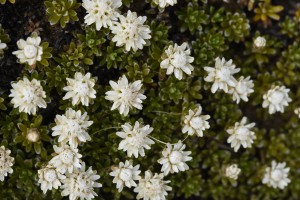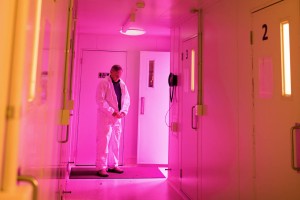Curious Minds visit Lincoln
In this section
-
Participating schools
- Curious Minds visit Lincoln
- Franz Josef & Fox Glacier Schools
- Greymouth High School
- Haast School
- Halswell Domain
- Halswell School
- Heathcote Valley School
- Kaniere School
- Kaniere visit Lincoln
- Hokitika Primary
- Leeston Consolidated School
- Manuka Primary School
- Mission Heights
- Mt Albert Grammar
- Paroa School
- Rudolf Steiner School
- Takapuna Grammar
- TKKM
- Wakaaranga Primary School
- Whataroa School

Students hunt for biocontrol insects on gorse.
The students 'won' the Lincoln visit by being the top project student nominated by their school.
Four participating schools from Westland were unable to visit us as they had other commitments (Franz Josef Glacier, Fox Glacier, Hokitika Primary and Whataroa schools). Brian Mason Scientific & Technical Trust funds supported the visit from Haast and Kaniere Schools in Westland.
The students and caregivers had two busy days, 9am‒4pm, touring the Allan Herbarium, then mounting and labelling selected specimens collected by their school group, and an online session exploring NatureWatch NZ and the observations their schools had recorded via smart phones. Day 1 ended with a visit to the harakeke (NZ flax) collection with Katarina.
To begin their second day, the students digitised specimens they'd mounted from the previous day. Then it was onto biocontrol of weeds, visiting the containment facility with Hugh. Robinne Weiss (an educator associated with our Unlocking Curious Minds project) kept everyone busy with some educational activities inside and then in the outdoor trial plots.
The two-day visit finished with written feedback and prize-giving including a smartphone each used during the school visits. The feedback was very positive and the students obviously had a great time. The caregivers also fully pitched in and learnt a lot from their time with us.
Programme
Day 1 – Herbarium activities (Thurs 8th Dec 2016, 9am–4pm)
- Welcome and introductions, H&S, housekeeping
Meet-and-greet with students and parents/caregivers from the schools, and Hugh, Murray, Ines, Katarina, and others from Landcare Research. Caregivers to join in over both days. - Tour of the Allan Herbarium with Ines
Tour by Ines featuring weeds and historic and research collections. - School projects on NatureWatch NZ
Exploring online observations that were made by the students using smartphones in their school areas. - Mounting specimens in the Herbarium Workroom
Students to mount and label selected specimens collected by their school groups. - Visit to harakeke (native flax) collection
An outside trip with Katarina to see this important collection of traditional weaving varieties and cultivars.
Day 2 – Biocontrol activities (Friday 9th Dec 2016, 9am–4pm)
- Digitising specimens in herbarium
Recap on Day 1 in the herbarium and digitising specimens mounted from the previous day. - Tour of Biocontrol Facilities
Tour with Hugh including introduction to biocontrol, current projects, and hands-on with biocontrol insects. - Biocontrol activities with Hugh
Learning about biocontrol with Hugh from Landcare Research. - Biocontrol learning activities with Robinne
Educational activities with Robinne, our South Island Educator, including searching for biocontrol agents outdoors. - Feedback, gifts, and farewells
Students to write about Landcare’s visits to their schools and their two days with us at Lincoln.
Feedback from students
Haast School (Charlotte, Y6)
On Day One we mounted our plants collected from Haast School onto white card from when the weedbusting team came to visit us last month.
We also had a tour of the Herbarium and learnt how plants are filed. We saw dried rata, kowhai, and a really cool cactus plant. My favourite was the butt coconut. We got to see Captain Cook's book with all the plants he collected 250 years ago.
We stripped flax leaves and made rope from the fibres.
On Day Two we got to see the seed library in the Herbarium. There were really cool fossilised plants too.
We studied bugs and learnt about which bugs eat which plants and learnt about biological control agents. We did an experiment where we had three kinds of plants - strawberry, hops and thistle. We had to cut circles out and spray with water. We put the caterpillars in and waited an hour for the caterpillars to eat the leaves. The caterpillars preferred thistles.
Thank you so much to Murray, Robinne, Hugh and the weedbusting team that came to our school. I had the best time and learnt so much.
Kaniere School (Sam, Y5)
When the weedbusters came to school we got sorted into groups and then went outside and found lots of plants like gorse, catsear, broom and aluminum plant. Then I had to log them on to the smartphones to identify them.
When we got to Lincoln we got our own plants back and Ines had dried them out for us. Ines showed us where she dried them, pressed them and chilled them to kill any bugs. We put them on card with tape and glue and stamped them - that was really fun. After that we went in to the herbarium and learnt how to file them. My favourite bit was when Ines showed us the bum coconut.
The next day we photographed our specimens then went out with Hugh to the containment area to learn about the biocontrols he is working on with bugs. Then we looked at bugs and caterpillars under the microscope which was my favourite part of the day. I also liked the pink light in the containment area.
We did cool experiments with Robinne and the caterpillars ate the nettles and we played snakes and ladders.
Thank you!
Mission Heights Junior College (Raiyan, Y7)
I used apps to identify weeds by figuring out the leaf shape and flower colour.
I learnt about the weed specimens and what biological control is used for. I also did an experiment with caterpillars and weeds plus plants. I also mounted our weed collections and we found out where they go. Then we got them photographed and renamed.
I enjoyed the time I spent at Landcare Research.
: )
Mt Albert Grammar (Lois, Y11)
I really enjoyed my time at Landcare but I think that my favourite activity was the caterpillar experiment. I learnt:
- That Biocontrol works better than chemicals although it takes a lot of work and time
- How you test agents
- Why we need to get rid of weeds
- How Biocontrol assessment can go wrong
- How to mount a pressed plant and take a picture of it
- The process of preserving plants
- How to find plants in the Herbarium and their Latin names
- How the containment facility works
- Advantages and disadvantages of using agents.
I learnt that to get rid of a weed effectively you need to: Find the weed -> Find its enemies -> Test the agents -> Release them onto the weed.
I found this trip very interesting and inspiring. I have decided not to write everything I learnt here as it would take too long.
Suggestions: Please do more trips so that other people can have this same experience.
Thank you for having me!
TKKM o Kawakawa Mai Tawhiti (Frank, Y9)
30th Nov & 1st Dec with Murray, Monique and Mark Tutty (Gisborne):
- Looked for some weeds
- Collected them
- Looked at seeds through the microscopes
- Asked what we would put in our own gardens
- We pressed and labelled the weeds.
8th December (Lincoln):
Ines told us that there are 640,000 specimens in the herbarium. We toured the old herbarium and the new parts. Ines showed us species that were collected by Captain Cook's botanists.
Our weeds were still in the press getting dry. Ines checked them and selected the ones that were ready to be mounted. We learnt how to mount with glue and straps.
9th December (Lincoln):
Next day we took a digital photo and learnt how they need to be set up for digitising: colour code, scan, print.
Biocontrol with Hugh: Hugh showed us his rooms that he keeps the insects in. Biocontrol will not eradicate a weed but will slow down the regrowth.
Thank you Murray and your Team for this opportunity to come and see what you do.




![Ines Schonberger explaining about the large herbarium specimens. [Lodoicea maldivica], the double ("bum") coconut is in the middle. Image](/assets/Education/Schools-Great-weeds-hunt/05_Ines_Schonberger_explaining_about_herbarium_specimens__FillMaxWzE1LDE1XQ.jpg)














![Gorse seed weevil [Exapion ulicis] Image](/assets/Education/Schools-Great-weeds-hunt/24_Gorse_seed_weevil-Exapion_ulicis__FillMaxWzE1LDE1XQ.jpg)


![Green thistle beetles [Cassida rubiginosa]. Image](/assets/Education/Schools-Great-weeds-hunt/27_Green_thistle_beetles-Cassida_rubiginosa__FillMaxWzE1LDE1XQ.jpg)








